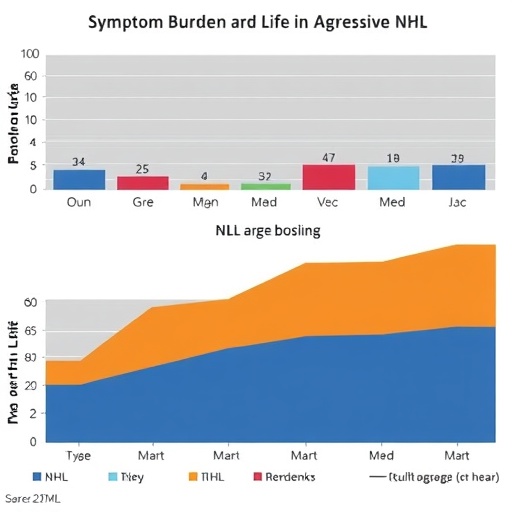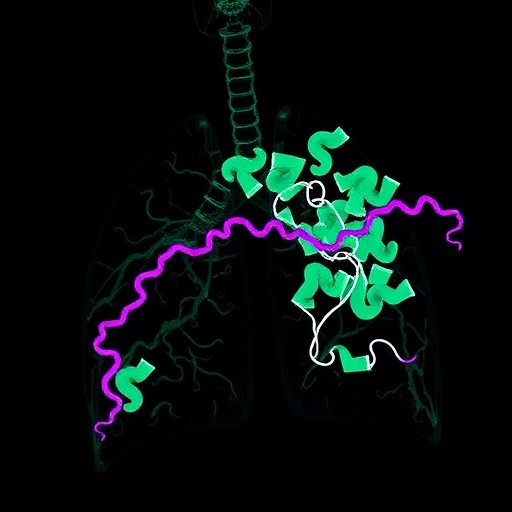
In a groundbreaking study set to reshape our understanding of lung adenocarcinoma, researchers have unveiled significant links between tumor growth dynamics, cellular proliferation markers, and immune profiles in ground-glass nodule-featured lung adenocarcinoma (GGN-LUAD). The intricate relationships among these factors shed new light on the progression of this particular subtype of lung cancer, potentially paving the way for improved prognostic assessments and targeted therapeutic strategies.
Lung adenocarcinoma, particularly when featured with ground-glass nodules, presents a diagnostic challenge due to its often indolent course and subtle radiological features. This study, published in BMC Cancer, meticulously examines the growth behavior of such nodules over an extended follow-up period exceeding one year, focusing on the correlations with Ki-67, a well-established marker of cellular proliferation, and various immune cell indicators including CD3, CD4, CD8, CD20, CD68, and CD163.
The researchers enrolled 67 patients with resected GGN-LUAD tumors, dividing them into growth and non-growth groups based on volume measurements. The growth group’s tumor doubling times were quantified, specifically using volume doubling time (VDT) and mass doubling time (MDT), providing quantitative metrics for tumor progression speed. These parameters are essential in understanding the biological behavior of the tumors in vivo.
Immunohistochemical analyses revealed stark contrasts between growing and non-growing nodules in their expression of Ki-67. The proliferation index was significantly elevated in the growth group, a finding that aligns with Ki-67’s role as a marker reflecting the fraction of cycling cells within a tumor. This elevation not only confirms the aggressive potential of nodules with higher Ki-67 but also emphasizes its utility as a prognostic biomarker in GGN-LUAD.
A deeper dive into the immune landscape provided fascinating insights. Among the growing nodules, CD3, a pan-T-cell marker, showed a significant positive correlation with volume doubling time. This suggests that a higher presence of T lymphocytes may be linked to slower tumor expansion, possibly indicating immune surveillance mechanisms at play that restrain rapid tumor propagation. Conversely, Ki-67 maintained a strong negative correlation with mass doubling time, reinforcing the view that rapid proliferation accelerates tumor mass increase.
The study further dissected a subgroup of 32 pathologically confirmed invasive adenocarcinomas within the growth group. Here again, CD3 expression correlated positively with VDT, underscoring the importance of T-cell infiltration even in more aggressive histological subtypes. This immune signature might reflect an intrinsic antitumor immune response, which could eventually be harnessed or amplified through immunotherapeutic modalities.
Interesting distinctions emerged when fast-growing and slow-growing nodules were compared. The slow-growth group exhibited significantly higher CD3 expression than their fast-growing counterparts. This key observation points to an inverse relationship between immune infiltration and growth rate, suggesting that immune cells play a pivotal role in modulating tumor kinetics within the lung microenvironment.
Mechanistically, the elevated Ki-67 expression in faster-growing nodules could be driven by oncogenic signaling pathways that override immune-mediated growth inhibition. Meanwhile, the higher CD3 counts in slower-growing nodules might represent a more competent or engaged immune system, which could slow tumor proliferation through cytotoxic activity or immune checkpoint mechanisms.
More broadly, this study contributes to the evolving narrative that cancer progression is not solely a function of intrinsic tumor properties but also involves complex interactions with the host immune environment. Understanding these interactions in GGN-LUAD provides a platform for developing novel biomarkers that combine proliferative indices with immune status, facilitating more nuanced risk stratification and management.
The implications extend beyond diagnostics; therapeutic strategies might be tailored according to immune and proliferation marker profiles. For example, nodules with high Ki-67 and low immune infiltration may benefit from treatments targeting proliferative pathways, while those with substantial immune presence could be candidates for immunomodulating agents, vaccine-based therapies, or checkpoint inhibitors.
The use of volume and mass doubling times in combination with molecular and cellular markers represents a powerful approach to characterize tumor aggressiveness. This comprehensive methodology not only captures phenotypic growth behavior but also integrates fundamental biological parameters, enhancing predictive accuracy.
This investigation also highlights the importance of longitudinal follow-up and precise imaging techniques in the management of ground-glass nodules, which often elude immediate clinical intervention due to their slow and variable growth patterns. The findings advocate for incorporating biomarkers like Ki-67 and immune profiles into routine diagnostic workflows, potentially informing decisions on monitoring intensity and surgical timing.
While Ki-67 has been studied extensively in various cancers, its specific role in GGN-LUAD growth dynamics has remained unclear until now. This research clarifies that Ki-67 positivity is a significant predictor of tumor growth, supporting its integration into prognostic models specific to lung adenocarcinomas presenting with ground-glass features.
The inverse relationship between CD3+ T-cell density and tumor growth offers intriguing prospects for the field of tumor immunology. It underscores the critical role of adaptive immunity in early-stage tumors and suggests avenues for immune-based interventions that could halt or slow tumor progression in situ.
Future research inspired by these findings could explore the mechanistic underpinnings of how Ki-67-driven proliferation interfaces with immune evasion strategies, examining whether boosting CD3+ T-cell responses could effectively counteract the proliferative drive. Moreover, investigating the spatial distribution and functional states of immune cells within these nodules could unravel finer details of immune-tumor interactions.
In summary, this research represents a significant advance in the characterization of GGN-LUAD by linking tumor growth kinetics with molecular proliferation markers and immune contexture. It opens new diagnostic and therapeutic vistas by underscoring the dual importance of tumor cell intrinsic traits and the microenvironment in lung adenocarcinoma progression.
As lung cancer remains a leading cause of cancer-related mortality worldwide, innovations that refine early detection and prognostication are of paramount importance. This study’s integrative approach offers a promising model for comprehensive tumor assessment that could ultimately improve patient outcomes in this challenging disease.
The findings invite a paradigm shift in how clinicians and researchers conceptualize tumor growth and immune interactions in early lung adenocarcinoma, inspiring a more personalized, biology-driven approach to cancer care where growth markers and immune cell profiling jointly guide clinical decisions.
Subject of Research: Relationships between tumor growth rate, cellular proliferation marker Ki-67, and immune cell indices in ground-glass nodule-featured lung adenocarcinoma (GGN-LUAD).
Article Title: Relationships between growth rate and Ki-67 and immune indices in ground-glass nodule-featured lung adenocarcinoma.
Article References:
He, Y., Che, S., Xie, J. et al. Relationships between growth rate and Ki-67 and immune indices in ground-glass nodule-featured lung adenocarcinoma. BMC Cancer 25, 686 (2025). https://doi.org/10.1186/s12885-025-14078-z
Image Credits: Scienmag.com
DOI: https://doi.org/10.1186/s12885-025-14078-z
Tags: correlations between tumor growth and immunityground-glass nodules in lung cancerimmune profiles in lung tumorsimmunohistochemical analysis in oncologyKi-67 cellular proliferation markerlongitudinal study of lung noduleslung adenocarcinoma researchpatient outcomes in lung adenocarcinomaprognostic assessments for lung adenocarcinomatargeted therapeutic strategies for lung cancertumor doubling time metricstumor growth dynamics in GGN-LUAD




